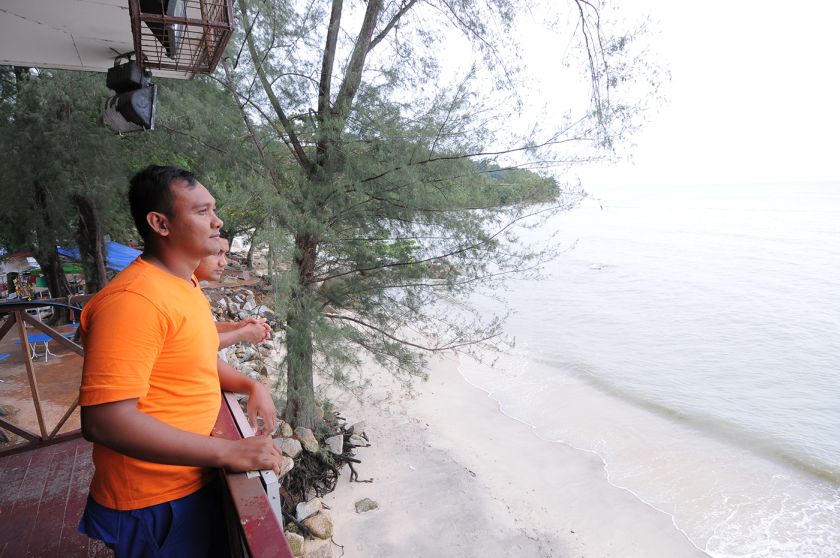GEORGE TOWN, Dec 26 ― Fifty-two people died in Penang and more than 200 were injured when giant waves, triggered by an undersea earthquake off Aceh in Indonesia, slammed into the island's coastline 10 years ago today.
Beachgoers at Penang's popular Batu Ferringhi had then been saved from the deadly tsunami when alert Civil Defence Department officers manning a watchtower near the Rasa Sayang luxury resort waved the red flag for danger and ushered them to higher ground.
However, picnickers along Miami Beach just two kilometres away and at Pantai Pasir Panjang in Balik Pulau never got any warning; there were no watchtowers on those beaches then.
Since that fateful day, four more watch towers have been built on the island, with three located along the Batu Ferringhi stretch popular with tourists and one along Pantai Pasir Panjang.
Each tower will have at least five officers on duty between 9am and 7.30pm daily, according to Jonhlennon Mubin, one of the Civil Defence Department officers guarding Miami Beach met by Malay Mail Online recently.
“One will be stationed in the tower and four others will be on different sites of the beach at any one time,” he said.
Similar to the life guards depicted in the “Baywatch” TV series popular in the 1990s, the watch tower officers mostly keep an eye over beachgoers and spring into action if anyone is having trouble in the sea, but they have also been well-trained to deal with tsunami situations.
“Once our headquarters give us the alert and the siren sounds, we will immediately evacuate everyone from the beach,” Jonhlennon said.
The 24-year-old said that he and his colleagues have received disaster training to deal with emergencies that arise from such crises, but admitted that none of them have personal experience with actual incidents, adding that it was hard to say what might happen should a tsunami strike again.
Since the 2004 Boxing Day tsunami tragedy, some 25 state and federal government agencies including the police, Fire and Rescue Department, Civil Defence Department, Welfare Department, Malaysian Maritime Enforcement Agency and the local councils have practised tsunami evacuation exercises annually.
There are also tsunami sirens installed at high-risk locations such as Tanjung Bunga, Teluk Bahang, Batu Ferringhi, Balik Pulau and Kuala Sungai Muda.
The Malaysian Meteorological Department has set up a Tsunami National Centre and an Early Warning Tsunami unit to monitor any unusual wave activity and ocean movement through seismic stations, deep sea buoys, tide gauges and closed-circuit televisions.
The department will either sound a tsunami alert or a warning if they detected any unusual waves and ocean movement following an earthquake.
Penang state executive councillor Phee Boon Poh believes all government agencies are well prepared to face any disaster, especially tsunamis, as they have conducted regular training and tsunami alert practises regularly.
He said a full tsunami alert drill was held last month, which was participated by all agencies. He added that such exercises are held at least once, sometimes twice a year.
He said the state government also has a detailed and systematic procedure of what to do in case of a tsunami repeat.
The procedure, he said, was implemented under the National Security Council’s Instruction 20 and grants the state secretary full full power to decide on the next course of action in accordance to the council’s safety and security guidelines.
Under the system, when the Malaysian Meteorological Department issued an alert, the state secretary will first inform the Penang chief minister before notifying all relevant departments such as the police, the fire and rescue department and the civil defence to move into action.
The foreign embassies will also be informed so that they will immediately contact and warn their citizens living here.
An operation centre will be immediately set up and both local councils will send out their enforcement teams to coastal areas to warn residents and locals while non-governmental organisations will be roped in to provide further assistance.
“All coastal residents will be evacuated to identified relief centres,” Phee said.
The only thing that might jeopardise the smooth running of the disaster management procedure was an uncooperative public, the state executive councillor said.
“For example, when we sounded the alarm during a practice last year, there was a big rush by the people in Gurney Plaza to leave in their cars, so they ended up clogging the roads and caused a massive traffic jam where nobody could go anywhere,” Phee said.
He also claimed that some seaside restaurants and residents have refused to evacuate their premises and homes during the tsunami alert exercises for fear of widespread looting in their absence.
“The public needs to cooperate in these exercises so that they know the full evacuation exercises, how to evacuate in a calm and orderly manner so that nobody gets hurt and where to go when evacuated in case of emergencies,” the lawmaker said.
However, Phee admitted there are currently no written guidelines for the public to follow.
Should a real life tsunami alert go out now, he advised the people to not panic and to follow the instructions issued by the authorities.



















